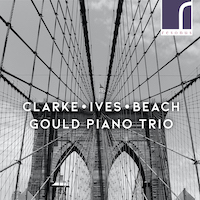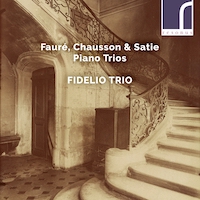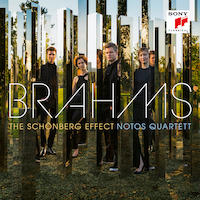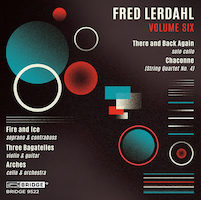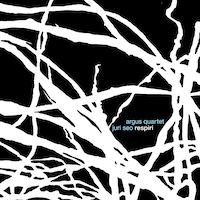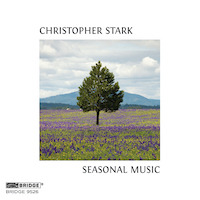String Theory 37: Sometimes with Piano
|
Grant Chu Covell [November 2021.]
Amy BEACH: Piano Trio, Op. 150 (1938). Charles IVES: Trio for Violin, Cello and Piano (1904-14). Rebecca CLARKE: Piano Trio (1921). Gould Piano Trio: Lucy Gould (vln), Richard Lester (vlc), Benjamin Frith (pno). Resonus RES10264 (1 CD) (www.resonusclassics.com). Both Beach and Ives overtly leverage folksongs. In the central, somber Lento espressivo, Beach quotes her own arrangement of an Inuit tune, and references another in the closing Allegro. Beach’s quotations add contrasting material and generate contrast within her employ of traditional forms. Written late in her life, the 1938 Trio embodies Beach’s Romantic style. Moving freely between college songs and hymn tunes, Ives’ allusions are pulped into the fabric of his piano trio. This may be one of Ives’ best completed works, but it is roughly cut, imperfect in places, but nonetheless content to be eccentric. Presumably Ives would not have thought much of Beach’s conservatism, likewise Beach would have faulted Ives’ technique. The American trios are a warmup for Clarke’s outstanding Trio whose adventurous and dissonant vocabulary suggests Ravel and Ysaÿe. Cyclic with a recurring martial gesture, perhaps Clarke was responding to the devastation of WWI. The Gould trio sounds best in the rewarding Clarke.
Ernest CHAUSSON: Piano Trio in G minor, Op. 3 (1881). Gabriel FAURÉ: Piano Trio in D minor, Op. 120 (1922-23). Erik SATIE: Prière pour le salut de mon âme (1895; arr. John WHITE, 2018); Le Piège de Méduse (1913; arr. WHITE, 2018). Fidelio Trio: Darragh Morgan (vln), Adi Tal (vlc), Mary Dullea (pno). Resonus RES10232 (1 CD) (www.resonusclassics.com). Chausson’s languid Trio was one of his first successful large-scale works, completed in his twenties; Fauré’s Trio is one of its composer’s last works, written in his late seventies. Both trios are Romantic, although Chausson inhabits a fussy world, whereas Fauré strives for elegance and gently nudges tonal boundaries. It startles that the principal theme in the Allegro vivo resembles the big tune from Pagliacci, which Fauré insisted was coincidental. Satie never wrote for string trio, but it is not a stretch to imagine these solo piano works thusly arranged. Originally incidental music, Le Piège de Méduse’s six pithy dances pass abruptly, whereas the halting Prière comes from Satie’s Messe des Pauvres. White’s clarifying distribution of Satie’s spare lines foreshadows Messiaen. As the program progresses, the music becomes simpler, although it surprises to realize Fauré’s work is the latest here.
“The Schoenberg Effect.” Johannes BRAHMS: Piano Quartet No. 1 in G minor, Op. 25 (1859-61); Symphony No. 3 in F major, Op. 90 (1884; arr. Andreas N. TARKMANN, 2017). Notos Quartett: Sindri Lederer (vln), Andrea Burger (vla), Philip Graham (vlc), Antonia Köster (pno). Sony 19439848002 (1 CD) (www.sonyclassical.com). There’s no Schoenberg here, yet he influences how we hear both piano quartets. Happily, the orchestral arrangement of Brahms’ G minor has become a common occurrence; Schoenberg had orchestrated it because he claimed it was seldom and badly played in his day. Nowadays, an ensemble might have the larger ensemble in mind when they tackle this chamber work, a strange, backwards influence. The Notos asked Tarkmann to arrange Brahms’ Third for piano quartet, and Schoenberg had to have been hovering nearly. But Tarkmann’s arrangement isn’t retro-Schoenberg, it is a lush reduction of something orchestral, well-suited to piano quartet, but not sounding like it had originated with these four players (although the Poco Allegretto works well). Tarkmann has found his own way in the recasting: wind parts are not always given to the piano; the original string lines may be distributed elsewhere. The piano is assertive, frequently carrying the pointed rhythms; key changes are more striking when Brahms can change timbres. Structurally, the symphony behaves well in its new guise, although it may lack the lightness or intrinsic interplay we find in Op. 25. Turn to Brahms’ original after the arrangement, and it’s evident he prospers when in control of ideas and their presentation. Had Schoenberg heard an ensemble like this, he probably wouldn’t have need to make his transcription.
“Fred Lerdahl: Volume Six” Fred LERDAHL: There and Back Again (2011)1; String Quartet No. 4, “Chaconne” (2016)2; Fire and Ice (2015)3; Three Bagatelles (2016)4; Arches (2011)5. Tom Kraines1 (vlc), Daedalus Quartet2: Min-Young Kim, Matilda Kaul (vln), Jessica Thompson (vla), Thomas Kraines (vlc), Elizabeth Fischborn3 (sop), Edwin Barker3 (cbs), Movses Pogossian4 (vln), David Starobin4 (guit), Toke Møldrup5 (vlc), Odense Symphony Orchestra5, Andreas Delfs5 (cond.). Bridge Records 9522 (1 CD) (www.bridgerecords.com). We’ve bumped into the Colombi variation, There and Back Again, before where its dedicatee Anssi Karttunen collected the full set of specially commissioned pieces. Lerdahl’s continuous development on Colombi’s bass line is echoed in Lerdahl’s equally resourceful string quartet, Chaconne. The Daedalus Quartet has made Lerdahl a specialty (the first three quartets form an interlocking series) and their diligence pays out for Quartet No. 4. Kraines smartly spotlights the Colombi variation. Modestly sized, the Robert Frost setting, Fire and Ice, for soprano and double bass, and the Three Bagatelles, for violin and guitar, reflect Lerdahl’s keen handling of motivic development and how pitches sound in their players’ specified registers. Lerdahl runs through Frost’s short poem several times, looking at the text from different angles as soprano and bass edge towards their extremes. The program’s largest work in time and scale, Arches for cello and orchestra, is hardest to grasp, perhaps because sustained orchestral textures do not reveal Lerdahl’s design as clearly as his chamber works. Among notable moments, I like the way the orchestral piano skitters away at the end.
Juri SEO: Respiri (2016)1; Suite for Cello (2018)2; String Quartet, “Infinite Season” (2017-18)3. Joann Whang2 (vlc), Argus Quartet1,3: Clara Kim, Jason Iassokson (vln), Dana Kelley (vla), Joann Whang (vlc). Innova 1022 (1 CD) (www.innova.mu). The brief opener, Respiri, written in memoriam Jonathan Harvey, emulates breathing, cleverly pulsing between consonance and feathery noise. The cello suite is five movements. Thinking of Bach is inevitable even though Seo offers minimal noodling across comfortably moving tonal spaces. Whang can be gruff, however Seo tends towards vigorousness. Respiri’s style flourishes among the substantial four-movement quartet, Infinite Season, a confident fusion of spirited tonal gestures. A lovely bright moment might be daubed with an atmospheric cloud or a quotation from the string quartet repertoire, as grand spaces are built and decorated. There are also bird sounds, imitated and introduced from tape which broaden the work’s vista.
Christopher STARK: Seasonal Music (2016-18)1; Piano Quartet (2014)2; This is Not a Story (2017)3. Momenta Quartet1: Emilie-Anne Gendron, Alex Shiozaki (vln), Stephanie Griffin (vla), Michael Haas (vlc), Los Angeles Piano Quartet2: Mikhail Kopelman (vln), Katherine Murdock (vla), Steven Doane (vlc), Xak Bjerken (pno), Scott Andrews3 (clar), Calyx Piano Trio3: Catherine French (vln), Jennifer Lucht (vlc), Nina Ferrigno (pno). Bridge Records 9526 (1 CD) (www.bridgerecords.com). Stark’s cleverness propels three chamber works, creating approachable contemporary surfaces which knowingly wink and grin. The string quartet, Seasonal Music, incorporates Vivaldi, Schoenberg and Schubert (and probably much other music that references the seasons), balancing filler and transitions between quickly changing statements. The Piano Quartet is similar, but its three movement’s dedications (to Johnathan Harvey, to Sean Shepherd (and Jake), and to Roberto Sierra), broaden the music’s associations. A Magritte homage, This is Not a Story, adds tape to the quartet of clarinet, violin, cello and piano. The central movement, Sorting Out Beethoven, references Op. 2, No. 1. All told, there’s a pleasing balance of astringent modernism and comforting familiarity. The pieces are lean and move quickly, but they lack gravity, and after the last bars fade away they’re hard to recall.
[More Grant Chu Covell, String Theory]
[More
Beach, Brahms, C Stark, Chausson, Fauré, Ives, J White, Lerdahl, R Clarke, Satie, Seo, Tarkmann]
[Previous Article:
Percussion Ramble with Toys]
[Next Article:
Used Bin Troll Tweets CCC.]
|
